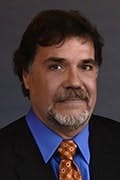Peter Asmus, Navigant Research
Peter Asmus, of Navigant Research, describes the European microgrid market and how it differs from the U.S. market.
The microgrid market in the United States has reached a crescendo, with vendors (i.e., SolarCity) and utilities (i.e., Oncor) announcing new products and projects on a regular basis. Here in Europe (where I am, just outside Paris and getting a pulse on the European markets for distributed energy), it is all quiet on the western front.
Well, not exactly. If we focus on Germany, a nation that is ground zero for problems related to high penetrations of distributed renewables, two different companies offer a snapshot of how microgrids are gaining ground here, albeit in a more calm and steady pace of development.
The first is Younicos of Berlin, a company I chose as one of the top five to watch in 2013. The company has since secured a partnership with Samsung SDI with performance guarantees on lithium ion battery technologies. More recently, it secured financing for the development of its flagship remote island microgrid on the Portuguese island of Graciosa.
Diesel Reduction
Younicos will partner with Swiss battery manufacturer Leclanche on the project, which will add the following resources to the existing diesel generator sets:
- A 4.5 MW wind farm utilizing General Electric wind turbines
- 1 MW of solar PV
- 2.7 MWh of lithium ion batteries
Of even greater importance to this project than the new partnership with Leclanche is the $3.5 million in convertible debt financing provided by ReCharge ApS, one of the Swiss battery vendor’s largest shareholders. The project, which has been delayed, in part due to the Euro crisis, should be online later this year. What’s most significant about this remote microgrid is that it will be able to operate in diesel-off mode for at least half of the time, realizing an annual renewable contribution of approximately 65 percent.
Along with the remote microgrid market, Younicos is also plowing forward with a number of grid-tied battery parks that not only provide frequency regulation services, but also are pioneering the development of new revenue streams that can flow from battery storage and grid-tied microgrids alike. The latest such deployment is in Dresden. Due in large part to its purchase of Xtreme Power, Younicos has an operational portfolio of approximately 100 MW; the company claims its project pipeline totals over 2 GW of potential energy storage and microgrid projects.
Keep it Simple
The key to the innovation Younicos is bringing to the microgrid/energy storage market is its power electronics. Another pioneer in that regard is Easy Smart Grid of Karlsruhe, Germany. Rather than focus on complex communications and smart meters, this company is focused on simple inverter-based solutions that follow innovations by Robert Lasseter of the University of Wisconsin, prime architect of the so-called CERTS software, which can run a microgrid autonomously based on droop frequency. Droop frequency is a technique long used in power generation but that is now being used to control microgrids without the need for sensing or smart meters. Thomas Walter, the brains behind Easy Smart Grid, takes this idea one step further. His controls technology, which can be applied to both grid-tied and remote systems, links small changes in frequency to pricing of power, enabling economic optimization without complex metering or other customized engineering solutions favored by larger technology companies. For example, if the frequency drops, that means demands on the system are up, and therefore the price of power is higher. This control concept also has immediate implications for the concept of virtual power plants and the emergence of the energy cloud.
Winner of the third best European start-up award for Smart Energy last year, Walters’ company is currently seeking investors, and it has also been in discussions with Younicos about piggy-backing on projects such as Graciosa, where its technology could offer a way to manage resources on an economic basis from the demand side without overly complex versions of a smart grid.
Peter Asmus is a principal research analyst for Navigant Research. This blog originally appeared on Navigant Research’s blog.







